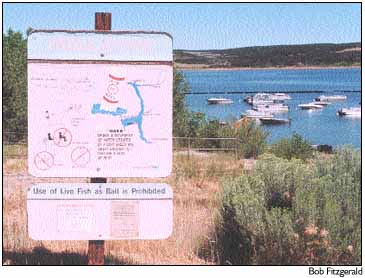|
July 24, 2001
By Janelle Holden A draft report by the U.S. Environmental Protection Agency says high levels of mercury, a toxic element, in the waters of local reservoirs are caused largely by mine tailings, although atmospheric pollution also contributes. For more than a decade, the Division of Wildlife has posted warning signs about the high levels of mercury in the fish at McPhee, Narraguinnep, and Totten reservoirs. But until recently, the source of the mercury pollution had never been studied. At the request of the Colorado Department of Public Health and Environment, the U.S. Environmental Protection Agency conducted a study of McPhee and Narraguinnep. Although in draft form, the study says that mercury is being deposited in McPhee at the rate of 3,049 grams a year, a load scientists say needs to be reduced by 1,235 grams in order to comply with the federal Clean Water Act. McPhee Reservoir, which has a storage capacity of 381,000 acre-feet, is fed directly by the Dolores River, which transports mercury from the remains of three metal-mining districts in the watershed: Rico, Dunton, and La Plata. An estimated 54 acres of land were disturbed from the Rico and Dunton mines alone, and the metal tailings continue to seep into the river. Narraguinnep, a smaller, 19,000 acre-foot reservoir, is largely fed by waters from McPhee through inter-basin transfer. Therefore, the two bodies of water were studied in conjunction. Nearly 10 percent of the mercury pollution in McPhee reportedly comes from the atmosphere. The study speculates that much of it is being carried from the Four Corners and San Juan power plants. A 1991 study estimated the coal-fired power plants put out 4,500 pounds of mercury per year. Other possible sources of airborne mercury are waste incinerators, smelters, and paper mills, the study says. Katherine Hernandez, an EPA specialist who worked on the study, said more tests need to be done to identify exactly where the atmospheric pollution is coming from. "We didnít put our money into studying the air component because we didnít think it would be that large," said Hernandez. Mercury poses a health threat to humans when it changes into an organic compound called methylmercury. It moves through the food chain and builds up in greater and greater quantities in the tissue of fish, particularly species that eat other fish. Mercury can likewise build up in the tissue of animals and humans who eat the fish. At a certain point, methylmercury can damage the central nervous system, causing illnesses similar to cerebral palsy. After a study of the reservoir fish was done in the early í90s, the Colorado Department of Public Health and Environment released a list of how much fish could safely be consumed in a month by children, pregnant women, and adults. For instance, pregnant and nursing women and children under 9 are advised not to eat any northern pike from Narraguinnep Reservoir that are between 30 and 36 inches long; adult men can eat two meals of northern pike that size a month. Mike Japhet, an aquatic biologist with the Division of Wildlife, said he would be surprised if the EPA study resulted in further restrictions on fish consumption, since the estimates made in the í90s were conservative. The ambient water in the reservoirs does not pose a health threat, according to Hernandez, nor do the fish species in the Dolores. "The fish that live in moving water are much less susceptible to accumulating a high level of mercury in their body," explained Japhet. "Typically itís the reservoir fish that are most susceptible to accumulating this mercury because they eat other fish, and thatís not as common in the river fish." Locals have speculated that gravel pits might have caused some of the mercury problem, but Hernandez said that is unlikely. "It wouldnít be someplace I would look for a source," said Hernandez. The final study should be available in two weeks, she said, and the EPA will be taking public comment this fall. The study will include recommendations on how to reduce the amount of mercury deposited in McPhee per year. |
||
|
Copyright © 2001 the Cortez Journal.
All rights reserved. |
